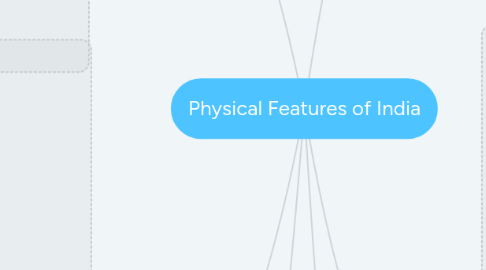
1. Northern Plains
1.1. 1. Interplay of Indus, Ganga, Brahmaputra with tributaries; Alluvial soil, formation
1.2. 2. Area= 7 lakh km2, Length= 2400 km, Breadth= 320 km
1.3. 3. Densely populated - Climate, Soil, Water, Even plain
1.4. 4. Rivers here show depositional work- riverine islands, distributaries, etc
1.5. 5. Three divisions: Punjab, Ganga, Brahmaputra
1.5.1. Punjab
1.5.1.1. 1. Western part; Indua and tributaries like Jhelum,Chenab, Ravi, Beas, Satluj
1.5.1.2. 2. Doabs
1.5.2. Ganga
1.5.2.1. 1. Between Ghaggar and Teesta rivers; Ganga and tributaries like Son, Kosi, Mahanada, Ramganga, etc.
1.5.2.2. 2. States: UP, Bihar, WB, Jharkhand
1.5.3. Brahmaputra
1.5.3.1. 1. Brahmaputra an dtributaries like Dihang, Dibang, Lohit, Manas
1.5.3.2. 2. East; Assam particularly
1.6. 6. Based on relief: Bhabar, Terai, Bhangar, Khadar
1.6.1. Bhabar
1.6.1.1. Narro belt of pebbles - 8 to 16 km wide; parallel to Shiwalik; Streams dissapear
1.6.2. Terai
1.6.2.1. Streams remerge, Wet swampy marshy, thivk forest, Dudhwa
1.6.3. Bhangar
1.6.3.1. Largest, Old alluvium, above floodplains, terrace like, Kankar soil
1.6.4. Khadar
1.6.4.1. Younger deposits, yearly renewed, fertile
2. Peninsular Plateau
2.1. 1. Tableland, igneous, metamorphic, crystalline
2.2. 2. Formation, oldest
2.3. 3. Broad shallow valleys, rounded hills
2.4. 4. Black soil- Deccan Trap. igneous
2.5. 5. Aravalis:W and NW, eroded, Gujarat to Delhi in SW to NE
2.6. 6. Two divisions: Central Highlands, Deccan Plateau
2.6.1. Central Highlands
2.6.1.1. 1. North of Narmada
2.6.1.2. 2. Major area of Malwa Plateau
2.6.1.2.1. 5. Avg height = 6000m
2.6.1.3. 3. S: Vindhyan; NW: Aravali; W: Rajasthan E: Bundelkhand, Baghelkhand; Further E: Chotanagpur - Damodar
2.6.1.4. 4. Chambal, Betwa, Sind, Ken (SW to NE)
2.6.2. Deccan Plateau
2.6.2.1. 1. Triangular, South of Narmada
2.6.2.2. 2. N: Satpura; E: Mahadev, Kaimur, Maikal range;NE: Meghalaya, Karbi Anglong Plateau, North Cachar hills (sep- Chotnag)
2.6.2.3. 3. Higher in West, slop - east; Garo, Khasi, Jaintia Hills
2.6.2.4. 4. W edge: Western Ghats; E edge: Eastern Ghats
2.6.2.4.1. Western Ghats
2.6.2.4.2. Eastern Ghats
3. Coastal Plains
3.1. 1. Location
3.2. 2. Western and Eastern
3.2.1. Western
3.2.1.1. Konkan , Kannad, Malabar
3.2.1.2. Rough, uneven
3.2.2. Eastern
3.2.2.1. Northern Circar, Coromandel Coast
3.2.2.2. Even, wide, Deltas, Chilka
4. Introduction
4.1. Different rock formations= Different types of soil
4.2. Theory of Plate Tectonics
4.2.1. The crust of the Earth has been formed out of seven major and some minor plates. The movement of these plates have resulted in the building up of stresses within the plates and the continental rocks above, leading into processes like folding, faulting and volcanic activity
4.3. Plate movements
4.3.1. Convergent
4.3.2. Divergent
4.3.3. Transform
4.4. Divisions
4.4.1. Himalayas
4.4.2. Northern Plains
4.4.3. Peninsular Plateau
4.4.4. Desert
4.4.5. Coastal Plains
4.4.6. Islands
4.5. Relief
4.5.1. Weathering
4.5.2. Erosion
4.5.3. Deposition
4.6. Gondwana Land
4.6.1. India, South Africa, South America, Australia, Antarctica (SSAI)
4.6.2. Formation of Himalayas out of geosyncline- Tethys
5. Himalayas
5.1. 1. Geologically and structurally young fold West to East; Indus to Brahmaputra
5.2. 2. Loftiest, rugged barriers, Siberian winds, SW monsoon
5.3. 3. Border north, arc of 2400 km, 400 km wide in Kashmir, 150 km wide in AP
5.4. 4. Three parallel ranges that run longitudinally - Himadri, Himachal, Shiwalik
5.4.1. Himadri
5.4.1.1. 1. Greater/ Inner, Northern most
5.4.1.2. 2. Loftiest peaks, highest and prominent ranges - Mt. Everest (8848m)
5.4.1.3. 3. Most continuous, perennially snow bound, Avg height = 6000 m
5.4.1.4. 4. Asymmetrical folds, core - granite
5.4.1.5. 6. Passes, Glaciers, Rivers
5.4.2. Himachal
5.4.2.1. 1. Lesser, South of Himadri
5.4.2.2. 2. Highly compressed, altered rocks
5.4.2.3. 3. Most rugged range
5.4.2.4. 4. Many valleys- Kashmir, Kangra, Kullu Many hill stations- Ranikhet, Mussorie
5.4.2.5. 5. Longest, imp = Pir Panjal, Others: Mahabharat, Dhaula Dhar
5.4.2.6. 6. Avg height = 3700 - 4500 m; Avg width =50 km
5.4.3. Shiwalik
5.4.3.1. 1. Outermost/ Lower
5.4.3.2. 2. Unconsolidated sediments
5.4.3.3. 3. Thick gravel, alluvium
5.4.3.4. 4. Avg height = 900- 1100 m
5.4.3.5. 5. Avg width = 10- 50 km
5.4.3.6. 6. Duns- Dehra, Kotli, Patli
5.5. 5. Four on river valley - Punjab, Kumaon, Nepal, Assam [Paul Kicked Nick's Arm (ISKTD) ]
5.6. 6. Purvanchal = Eastern hills and mountains; Dihang; NE states; Strong sandstones (sedimentary); Patkai, Naga, Manipur, Mizo hills
6. Islands
6.1. Andaman and Nicobar
6.1.1. 1. 572 islands, location
6.1.2. 2. Submarine..
6.1.3. 3. Flora and Fauna
6.1.4. 4. Port Blair
6.2. Lakshadweep
6.2.1. 1. 32 km2, location (coral)
6.2.2. 2. Laccadive Minicoy Amindive to new in 1973
6.2.3. 3. Pitti bird sanctuary, flora & fauna
6.2.4. 4. Kavaratti
